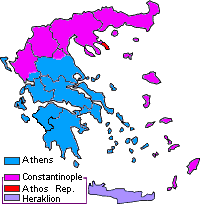
The tomos dated 29 June 1850 is the official decree of the Ecumenical Patriarchate which gave de jure autocephaly to the then- de facto autocephalous Church of Greece.

The tomos dated 29 June 1850 is the official decree of the Ecumenical Patriarchate which gave de jure autocephaly to the then- de facto autocephalous Church of Greece.
The decision to create an independent Kingdom of Greece from the Three Great Powers (the British Empire, the Russian Empire and the Kingdom of France), finalized by the Treaty of Constantinople (1832), posed a dilemma for Greek patriarchal and religious society: whether there is an independent Church of Greece or in the independent state extends the ecclesiastical jurisdiction of the Ecumenical Patriarchate of Constantinople. [1]
The government declared the Church of Greece to be autocephalous in 1833 in a political decision of the Bavarian regents acting for King Otto, who was a minor. The decision roiled Greek politics for decades as royal authorities took increasing control.
In the end, the Ecumenical Patriarchate of Constantinople decided on a compromise: the Ecumenical Patriarchate agreed to give autocephaly to the Church of Greece through a tomos which was dated 29 June 1850.
The decision of the Ecumenical Patriarchate to give autocephaly to the Church of Greece catalyzed the Bulgarian National Revival and ultimately led to the Bulgarian schism after which ethnophyletism was condemned.
The tomos dated 29 June 1850 was fastened by a royal decree of 15 August 1850, after which Law No. 201 of 9 July 1852 was adopted, called the Statute for the Holy Synod of the Greek Church. Two laws (200 and 201) were inspired by state churches in Protestant countries, in which the monarch is the formal head of the church. Consequently, the Statute decrees that the King is the head of the Greek Church. Its supreme authority was the Synod appointed by the King. [2] A royal plenipotentiary wielded veto powers on behalf of the monarch. Between 1860 and 1923, the church was subject to royal and national politics. [3]
Mount Athos, Crete, Macedonia, Thrace, and the eastern Aegean Islands remained under the Ecumenical Patriarchate.
The Eastern Orthodox Church is a communion comprising the fourteen or sixteen separate autocephalous (self-governing) hierarchical churches that recognize each other as "canonical" Eastern Orthodox Christian churches.
Autocephaly is the status of a hierarchical Christian church whose head bishop does not report to any higher-ranking bishop. The term is primarily used in Eastern Orthodox and Oriental Orthodox churches. The status has been compared with that of the churches (provinces) within the Anglican Communion.
The Orthodox Church in America (OCA) is an Eastern Orthodox Christian church based in North America. The OCA is partly recognized as autocephalous and consists of more than 700 parishes, missions, communities, monasteries and institutions in the United States, Canada and Mexico. In 2011, it had an estimated 84,900 members in the United States.

The Ecumenical Patriarchate of Constantinople is one of the fourteen to sixteen autocephalous churches that together compose the Eastern Orthodox Church. It is headed by the Ecumenical Patriarch of Constantinople, currently Bartholomew I, Archbishop of Constantinople.

The Ukrainian Autocephalous Orthodox Church was one of the three major Orthodox churches in Ukraine. It was reestablished for the third time in 1990, right before the fall of the Soviet Union. The UAOC, in its contemporary form, has its origins in the Sobor of 1921 in Kyiv, shortly after Ukraine's newly found independence. On 15 December 2018, at the Unification Council, the UAOC and the UOC-KP, along with metropolitans from the UOC-MP, unified into the Orthodox Church of Ukraine. Metropolitan Epiphany was elected as the new Metropolitan of Kyiv and All Ukraine.

The Bulgarian Orthodox Church, legally the Patriarchate of Bulgaria, is an autocephalous Orthodox jurisdiction. It is the oldest Slavic Orthodox church, with some 6 million members in Bulgaria and between 1.5 and 2 million members in a number of European countries, the Americas, Australia, New Zealand and Asia. It was recognized as autocephalous in 1945 by the Ecumenical Patriarchate of Constantinople.

The Bulgarian Exarchate was the official name of the Bulgarian Orthodox Church before its autocephaly was recognized by the Ecumenical See in 1945 and the Bulgarian Patriarchate was restored in 1953.
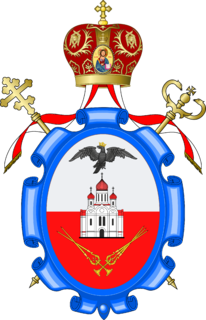
The Polish Autocephalous Orthodox Church, commonly known as the Polish Orthodox Church, or (Orthodox) Church of Poland is one of the autocephalous Eastern Orthodox churches in full communion. The church was established in 1924, to accommodate Orthodox Christians of Polish descent in the eastern part of the country, when Poland regained its independence after the First World War.

The Ukrainian Orthodox Church – Kyiv Patriarchate was an unrecognized Orthodox church in Ukraine which existed since 1992 and merged into the Orthodox Church of Ukraine in 2018. In 2019, the former leader of the church Filaret (Denysenko) has declared its "revival" following his conflict with Epiphanius, however, it was not supported by the majority of the bishops of former Kyiv Patriarchate. As of 2021, the juridical person of UOC-KP is officially stopped.
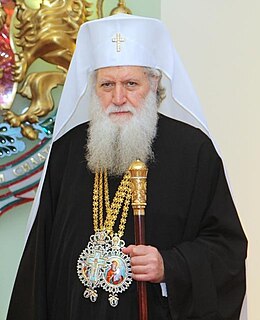
The patriarch of All Bulgaria is the patriarch of the Bulgarian Orthodox Church. The patriarch is officially styled as Patriarch of All Bulgaria and Metropolitan of Sofia. Patriarch Neophyte acceded to this position on 24 February 2013.

Anthimus IV, was twice Ecumenical Patriarch of Constantinople, between 1840 and 1841, and between 1848 and 1852. He was born in Constantinople and served as Chancellor of the Ecumenical Patriarchate before being elected Metropolitan of Ikonion (Konya) between 1825 and 1835, Larissa between 1835 and 1837, and Nikomedeia between 1837 and 1840.

The Orthodox Church of Ukraine (OCU) is a partially recognized autocephalous Eastern Orthodox church whose canonical territory is Ukraine.
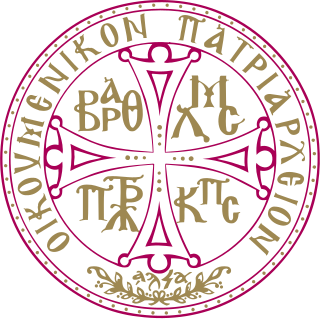
A schism between the Russian Orthodox Church and the Ecumenical Patriarchate of Constantinople began on 15 October 2018 when the former unilaterally severed full communion with the latter.

In 1996 a schism between Moscow and Constantinople occurred; this schism began on 23 February 1996, when the Russian Orthodox Church severed full communion with the Ecumenical Patriarchate of Constantinople, and ended on 16 May 1996 when the Russian Orthodox Church and the Ecumenical Patriarchate reached an agreement.

The Unification council of the Eastern Orthodox churches of Ukraine is a council which was held on 15 December 2018 in the St Sophia's Cathedral in Kyiv. The council voted to unite the existing Ukrainian Eastern Orthodox churches through their representatives, on the basis of complete canonical independence. All the members of the UOC-KP and the UAOC, and two members of the UOC-MP, merged into the Orthodox Church of Ukraine and the unification council elected Epiphanius I as its first primate.

On 5 January 2019, Bartholomew I, the Ecumenical Patriarch of Constantinople, signed the tomos that officially recognized and established the Orthodox Church of Ukraine and granted it autocephaly (self-governorship). The events immediately leading to the grant of autocephaly were:
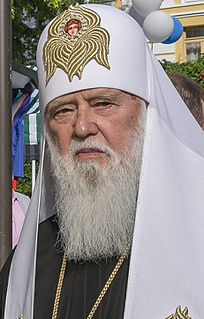
The conflict between Filaret and Epiphanius is an ecclesiastical conflict that arose inside the Orthodox Church of Ukraine (OCU) due to disagreements concerning the model of governance, the management of the diaspora, and the name and the charter of the OCU. The conflict started during the process of the granting of autocephaly to the Orthodox Church of Ukraine (2018-2019) and continued after the reception of the tomos of autocephaly of the OCU. The conflict involves Filaret along with his supporters, and Metropolitan Epiphanius along with his supporters - as well as the bishops of the Ecumenical Patriarchate - who advocate a different model of church management.
A schism between the Ecumenical Patriarchate and part ofitsMetropolis of Kiev and all Rus' occurred between approximately 1467 and 1560. This schism de facto ended supposedly around 1560.

Metropolitanate of Kyiv was an autonomous metropolis of the Ecumenical Patriarchate of Constantinople with center in Kyiv after its formation in 988 as a result of the Christianization of Rus by Volodymyr the Great until January 6, 2019, when it received the Tomos on Autocephaly.